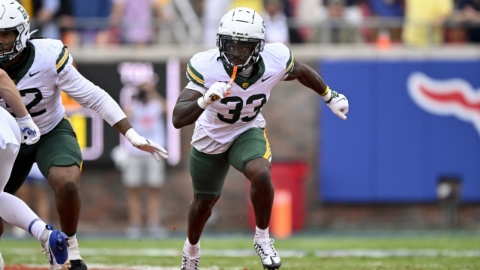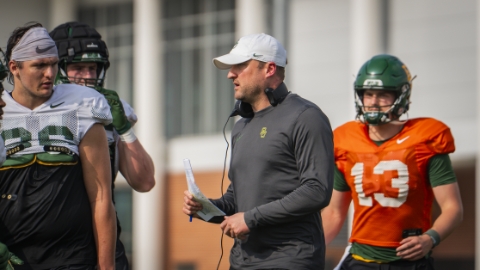
Baylor returns home to take on the Horned Frogs this weekend. TCU comes to Waco after losing three of their last four games to Oklahoma, West Virginia and Texas Tech. Two of these games came down to the wire and the Frogs will present a challenge for a Baylor team looking to put last weekend's setback behind them. Baylor will be looking to even the score with the Frogs and head coach Gary Patterson after a double-overtime loss last fall in Fort Worth.
TCU will typically line up with four receivers or three receivers and a tight end. The Frog offense is obviously more potent than Kansas or NSU ever thought of being but Oklahoma State is a better comparison point. TCU is a stronger running team than OSU but their passing game execution isn't as good as the Cowboys right now.
TCU will typically use zone, power, and draw as their main run schemes but will incorporate QB reads, options, and designed qb runs.
 SicEm365
With that said, the Frogs average around 30 per drive against these teams which is far from anemic. This offense has weapons and can make big plays. They also racked up over 43 yards per drive in their two non-P5 games against a decent SMU team and one of the better FCS teams out there.
SicEm365
With that said, the Frogs average around 30 per drive against these teams which is far from anemic. This offense has weapons and can make big plays. They also racked up over 43 yards per drive in their two non-P5 games against a decent SMU team and one of the better FCS teams out there.
In the Red Zone the Frogs scored around 70% of the available points they potentially could scored against Power 5 teams.
This team averages 30 points per game against Power 5 opponents that collectively gave up 39.5 per game to their other P5 competition.
Hill's inconsistency did however lead to him being replaced by #12 Foster Sawyer (6-5, 230, SO) who is athletic, but not nearly as elusive as Hill. Sawyer is a former prized recruit with a big arm who started against OU last year when Boykin was hurt.
At tailback, TCU has #21 Kyle Hicks (5-10, 210, JR) who is a very good tailback and deserves his spot on the Doak Walker award watch list. He's a physical back with dynamic ability. He turned a short pass into a 61 yard touchdown against Oklahoma. However, he has been fighting injury so I am not sure if he will be 100% on Saturday. Gary Patterson was not shy about singing his praises in calling him TCU's best player.
Also seeing time at tailback is freshman #33 Sewo Olonilua (6-3, 225, FR), Michigan transfer #27 Derrick Green (5-11, 234, SR), #24 Trevorris Johnson (5-11, 226, JR), and #6 Darius Anderson (5-11, 194, FR) who has forced his way onto the field as a true freshman.
At wide receiver the Frogs feature a lot of upside but are still finding a rhythm. Very highly touted JC recruit #2 Taj Williams (6-4, 193, JR) is the starter at the X receiver position. He has two touchdowns of over 60 yards and can be a game breaker with the added bonus of 6-4 height. At the Z receiver position TCU starts #1 Emanuel Porter (6-4, 210, JR) who is experienced and is another athletic target. #15 Jaelan Austin (6-2, 200, SO) also sees time at Z and leads the team with 5 touchdowns. Backing up Williams is #83 Daniel Walsh (6-2, 190, SR) who is reliable and gets open.
In the slot the Frogs feature one of the Big 12's most dangerous players starting at the H receiver, #25 KaVontae Turpin (5-9, 153, SO), who is incredibly elusive in the open field. He is backed up by similar open field threats #10 Desmon White (5-7, 160, JR) and part-time corner #20 Deante Gray (5-10, 183, SR).
At the Y-Slot receiver position the Frogs return 2014 starter #13 Ty Slanina (6-1, 195, JR) who is a very good route runner and has 77 career receptions. He splits time with LSU transfer #9 John Diarse (6-1, 209, JR) who is yet another athletic target.
When the Frogs use a tight end they will use Rice transfer #81 Cole Hunt (6-7, 250, JR) who is a well rounded player who can block and be a part of the passing game.
On the offensive line TCU has been stable but not as outstanding as they were in 2014 and 2015. Left tackle #68 Joseph Noteboom (6-5, 315, JR) and #51 Austin Schlottmann (6-6, 300, JR) are the headliners of a unit that generally does a decent job.
TCU's offense has struggled the last three games and especially against Texas Tech. What happened against the Red Raiders?
Tech spent a lot of the game simply daring TCU to throw. As you can see in the video below, they outnumbered the run and forced either TCU quarterback to deliver accurate passes and forced the TCU offensive line to pick up blitzes. This helped Tech keep the run game in check and hit on a weakness of TCU's offense; their quarterback play is not where it was with Boykin and TCU wasn't able to exploit what Tech was giving them in the air. Tech certainly mixed in some of their zone looks as well but a significant portion of the game was spent doing this.
Honestly it reminds me of the 2014 Baylor defense against Boykin.
OFFENSE
Our preview begins with the TCU offense which is coordinated by Doug Meacham and Sonny Cumbie. Like previous Baylor opponents (NSU, OSU, KU) they run a variation on the popular Air Raid offense popularized by former Texas Tech head coach Mike Leach and former Kentucky coach Hal Mumme. I broke down some Air Raid staples in the NSU Preview.TCU will typically line up with four receivers or three receivers and a tight end. The Frog offense is obviously more potent than Kansas or NSU ever thought of being but Oklahoma State is a better comparison point. TCU is a stronger running team than OSU but their passing game execution isn't as good as the Cowboys right now.
TCU will typically use zone, power, and draw as their main run schemes but will incorporate QB reads, options, and designed qb runs.
PERFORMANCE TO DATE
Statistically this offense has under performed relative to what other Power 5 competition has done against their power opponents. As you can see in the game by game chart, the Frogs have consistently struggled to match what their opponent has done in yards per drive with the Texas Tech game as the most notable example where TCU gained almost 18 fewer yards than Tech typically gives up. SicEm365
SicEm365
In the Red Zone the Frogs scored around 70% of the available points they potentially could scored against Power 5 teams.
This team averages 30 points per game against Power 5 opponents that collectively gave up 39.5 per game to their other P5 competition.
PERSONNEL
The starting quarterback for this season is Texas A&M transfer #7 Kenny Hill (6-1, 205, JR) who is the son of MLB great Ken Hill. He is an athletic and dangerous player with a live arm. He struggles with consistency but has all the upside you want. He hit several big plays against Oklahoma.Hill's inconsistency did however lead to him being replaced by #12 Foster Sawyer (6-5, 230, SO) who is athletic, but not nearly as elusive as Hill. Sawyer is a former prized recruit with a big arm who started against OU last year when Boykin was hurt.
At tailback, TCU has #21 Kyle Hicks (5-10, 210, JR) who is a very good tailback and deserves his spot on the Doak Walker award watch list. He's a physical back with dynamic ability. He turned a short pass into a 61 yard touchdown against Oklahoma. However, he has been fighting injury so I am not sure if he will be 100% on Saturday. Gary Patterson was not shy about singing his praises in calling him TCU's best player.
Also seeing time at tailback is freshman #33 Sewo Olonilua (6-3, 225, FR), Michigan transfer #27 Derrick Green (5-11, 234, SR), #24 Trevorris Johnson (5-11, 226, JR), and #6 Darius Anderson (5-11, 194, FR) who has forced his way onto the field as a true freshman.
At wide receiver the Frogs feature a lot of upside but are still finding a rhythm. Very highly touted JC recruit #2 Taj Williams (6-4, 193, JR) is the starter at the X receiver position. He has two touchdowns of over 60 yards and can be a game breaker with the added bonus of 6-4 height. At the Z receiver position TCU starts #1 Emanuel Porter (6-4, 210, JR) who is experienced and is another athletic target. #15 Jaelan Austin (6-2, 200, SO) also sees time at Z and leads the team with 5 touchdowns. Backing up Williams is #83 Daniel Walsh (6-2, 190, SR) who is reliable and gets open.
In the slot the Frogs feature one of the Big 12's most dangerous players starting at the H receiver, #25 KaVontae Turpin (5-9, 153, SO), who is incredibly elusive in the open field. He is backed up by similar open field threats #10 Desmon White (5-7, 160, JR) and part-time corner #20 Deante Gray (5-10, 183, SR).
At the Y-Slot receiver position the Frogs return 2014 starter #13 Ty Slanina (6-1, 195, JR) who is a very good route runner and has 77 career receptions. He splits time with LSU transfer #9 John Diarse (6-1, 209, JR) who is yet another athletic target.
When the Frogs use a tight end they will use Rice transfer #81 Cole Hunt (6-7, 250, JR) who is a well rounded player who can block and be a part of the passing game.
On the offensive line TCU has been stable but not as outstanding as they were in 2014 and 2015. Left tackle #68 Joseph Noteboom (6-5, 315, JR) and #51 Austin Schlottmann (6-6, 300, JR) are the headliners of a unit that generally does a decent job.
TCU's offense has struggled the last three games and especially against Texas Tech. What happened against the Red Raiders?
Tech spent a lot of the game simply daring TCU to throw. As you can see in the video below, they outnumbered the run and forced either TCU quarterback to deliver accurate passes and forced the TCU offensive line to pick up blitzes. This helped Tech keep the run game in check and hit on a weakness of TCU's offense; their quarterback play is not where it was with Boykin and TCU wasn't able to exploit what Tech was giving them in the air. Tech certainly mixed in some of their zone looks as well but a significant portion of the game was spent doing this.
Honestly it reminds me of the 2014 Baylor defense against Boykin.
How well do you think that game plan could be copied?
It's tough to say as I can assure you TCU is going to be practicing the parts of the playbook that deal specifically with this. How much can their execution improve in a week? WVU had some success with it but didn't stick with it and TCU was able to run a little bit on them.Foster Sawyer or Kenny Hill? What's the difference?
Kenny Hill has the potential to make dynamic plays with his feet where Sawyer seems to be a bit more robotic in his movement and less likely to create a big play on his own. As far as decision making or accuracy there isn't enough of a sample size on Foster to really say. Both had their struggles but each has hit big plays for TCU.TCU was one of the best offenses in the country last year, what has led to TCU being less capable on offense?
I think the inconsistency at quarterback is brutal for a pass centered offense to overcome. On top of that losing Aaron Green at tailback, Doctson and Listenbee at receiver with four starters on the offensive line is an issue. The guys blocking for them simply aren't what they had last year.What was their best game on offense?
I would say Oklahoma if we are taking the quality of opponent into consideration. The Frogs busted several big plays and put a ton of pressure on OU to score. The other sequence of theirs that was really well done was the second half against Arkansas where they averaged 48 per drive prior to a 40 second drive where they attempted a field goal on third down to try and win in regulation.Never miss the latest news from SicEm365!
Join our free email list



